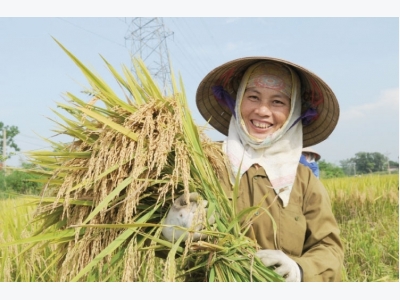Rice sector needs breakthrough strategy

Prime Minister Nguyen Xuan Phuc has told rice farmers and producers that a new vision and strategic plans are vital if Vietnam is to become the world’s biggest rice supplier. Phuc spoke at a conference he chaired in An Giang Province on March 15 to discuss sustainable rice sector development in the Mekong Delta in light of major problems.
The PM pointed out that the Vietnamese rice sector also plays a key role in ensuring national food security. Specifically, farming areas must be expanded to form large-scale rice fields, links between farmers and businesses must be promoted, and cooperatives have to be re-organized to benefit rice growers. Improving the efficiency of rice production, applying mechanization, speeding up deep processing, and restructuring the agricultural sector are necessary, the PM said.
Agriculture and Rural Development Minister Nguyen Xuan Cuong said the Mekong Delta provides more than 50 percent of rice output and 90 percent of Vietnam’s rice export volume. However the rice sector is facing great challenges due to climate change and low production efficiency.
Rice exports are also facing difficulties because of non-tariff barriers and food self-sufficiency of importers. Deputy Minister of Agriculture and Rural Development, Le Quoc Danh, said that during the 1995-2015 period, the Mekong Delta’s rice output recorded a strong growth of 25.7 million tonnes a year, accounting for nearly 60 percent of the country’s total output. However, many weaknesses in this sector need to be addressed, such as low value chain efficiency due to high loss rate of 13.7 percent, low quality of rice, and inadequacies in profit distribution and risk sharing between farmers and businesses.
Fierce competition Regarding exports, Industry and Trade Minister Tran Tuan Anh said that in the context of international economic integration, rice competition is fierce. In particular, the trend of protecting domestic markets is the biggest challenge for Vietnam’s rice exports.
Bui Thi Thanh Tam, the general director of the Vietnam Northern Food Corporation (Vinafood 1), said Vietnam produces more than 200 rice varieties, so it is hard to control the quality. In addition, production organization, processing and consumption are facing problems.
Pham Thai Binh, the general director of the Can Tho City-based Trung An Hi-Tech Farming Joint-Stock Company, said that developing a value chain as part of a major program to develop the large-scale rice field model is the right direction. But there remain problems, including loose cooperation between farmers and businesses in rice production and consumption.
According to the Ministry of Industry and Trade, three main issues need to be addressed, including production organization, markets and exports. Production organization must move toward improving quality, ensuring food hygiene and safety, applying modern production processes, and creating favorable conditions through mechanisms and policies to attract more investment from businesses.
Incentives It is necessary to build market development strategies by strengthening negotiations to expand markets and creating favorable conditions for businesses to develop new markets. Businesses must also have strategies in place to maintain the development of the domestic market and expand the wholesale and retail systems.
Regarding exports, the Ministry of Industry and Trade will also push forward negotiations on market expansion through tax cuts, distribution system development and niche market exploitation.
The Ministry of Industry and Trade abolished Decision 6139/QD-BCT on the planning of rice exporters in January 2017, and continues to consider reorganizing the functions and duties of the Vietnam Food Association (VFA) to ensure stability and develop branding.
The VFA proposed solutions to production development based on improving quality and efficiency. In addition, they also suggested targeting exports of four million tonnes of rice per year through 2020, and two to three tonnes of rice per year until 2030.
According to the General Department of Vietnam Customs, rice exports in 2016 reached more than 4.8 million tonnes and over US$2.1 billion in revenues, a drop of 26.5 percent in volume and 22 percent in value compared to 2015. In the first two months of this year, Vietnam exported 787,235 tonnes of rice valued at more than US$328 million, a drop of 18.5 percent in volume and 21.4 percent in value compared to a year ago.
Có thể bạn quan tâm
 Access to 'easy-going' market: Precaution against risks
Access to 'easy-going' market: Precaution against risks Until now, many Vietnamese exporters are still subjective when trading, working with some markets are considered as "easy - going" as the markets of Middle East
 US authorises import of fresh star apples from Vietnam
US authorises import of fresh star apples from Vietnam The Animal and Plant Health Inspection Service (APHIS) of the US Department of Agriculture authorised imports of fresh star apples from Vietnam
 Dragon fruit farmers supported with energy-saving lights
Dragon fruit farmers supported with energy-saving lights More than 2,300 households growing dragon fruits in Binh Thuan, Long An, and Tien Giang provinces have been assisted to replace 2 million incandescent